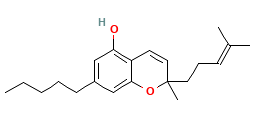Move over, CBD and THC. Discover CBC (Cannabichromene), a non-psychoactive cannabinoid gaining traction for its unique potential and role in the coveted "entourage effect." Learn about the science behind CAS 20675-51-8.

Figure 1: The molecular structure of Cannabichromene (CBC).
Unveiling CBC: A Minor Cannabinoid with Major Potential
In the vast and complex world of cannabis phytochemistry, most of the spotlight shines on two players: THC, known for its psychoactive properties, and CBD, celebrated for its wellness applications. However, the cannabis plant produces over a hundred other cannabinoids, each with unique characteristics. Today, we focus on one of the most promising among them: Cannabichromene (CBC).
CBC, with its CAS registry number 20675-51-8, is a non-psychoactive cannabinoid, meaning it does not produce the "high" associated with THC. Like its more famous cousins, it originates from Cannabigerolic acid (CBGA), often called the "mother of all cannabinoids." Through enzymatic processes in the plant, CBGA converts to Cannabichromenic acid (CBCA), which then becomes active CBC through decarboxylation (typically via heat).

Fig2:CBC crystalline solid
CBC's mechanism of action sets it apart. Unlike THC, which binds strongly to the CB1 receptors in the brain, CBC has a very low affinity for these classic cannabinoid receptors. Instead, it exerts its potential effects through other key pathways:
While human clinical trials are still in their early stages, pre-clinical research (in vitro and in animal models) has identified several promising areas for CBC. It's crucial to note these are research findings, not confirmed medical claims.
•Neurological Health: Early studies suggest that CBC may support the health of neural stem progenitor cells (NSPCs), which are essential for healthy brain function. This indicates a potential role in supporting neurological wellness.
•Inflammatory Response: Research has shown that CBC may demonstrate properties that help manage the body's inflammatory response, potentially offering a natural alternative for discomfort management.
•Mood Support: Similar to CBD, CBC may positively influence mood by interacting with the endocannabinoid system, which plays a role in regulating emotional response.
•Skin Health: Due to its potential properties, CBC is increasingly being included in topical skincare formulations aimed at promoting clear, healthy skin.

Figure 2: The most important cannabinoids (THC, CBD, CBC, CBG, CBN) and their therapeutic effects
CBC in Modern Product Formulations
As the market for sophisticated cannabinoid products evolves, CBC is moving from a minor ingredient to a star component in advanced formulations. You can find it in:
Safety and Legality
CBC is generally considered safe and well-tolerated. It is non-intoxicating and does not cause euphoria or impairment. In the United States, CBC derived from hemp containing less than 0.3% THC is federally legal under the 2018 Farm Bill. Always check your local regulations.
We are committed to providing accurate, science-backed information. The insights in this article are based on research published in reputable scientific journals and databases.
1.National Center for Biotechnology Information (2023). PubChem Compound Summary for CID 5315849, Cannabichromene. Retrieved from:
https://pubchem.ncbi.nlm.nih.gov/compound/Cannabichromene
•For verified chemical data on CBC (CAS 20675-51-8).
2.Russo, E. B. (2011). Taming THC: potential cannabis synergy and phytocannabinoid-terpenoid entourage effects. British Journal of Pharmacology, 163(7), 1344–1364.
•The seminal paper on the entourage effect, discussing the role of minor cannabinoids.
3.Iannotti, F. A., et al. (2014). Nonpsychotropic plant cannabinoids, cannabidivarin (CBDV) and cannabichromene (CBC), inhibit the proliferation of human bladder cancer cells in vitro. European Journal of Pharmacology, 740, 1–7.
•An example of pre-clinical research into CBC's potential applications.
4.DeLong, G. T., et al. (2010). Pharmacological evaluation of the natural constituent of Cannabis sativa, cannabichromene and its modulation by Δ9-tetrahydrocannabinol.
5.https://www.kalapa-clinic.com/en/the-most-important-cannabinoids-thc-cbd-cbc-cbg-cbn-and-their-therapeutic-effects/
Leave A Message
Scan to Wechat/Whatsapp :

